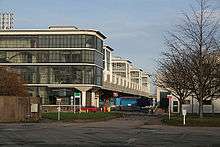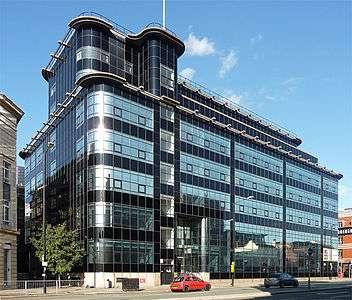Owen Williams (engineer)
| Sir Owen Williams | |
|---|---|
|
Owen Williams, circa 1960s. | |
| Born |
Evan Owen Williams 20 March 1890 Tottenham, London |
| Died |
23 May 1969 (aged 79) Hemel Hempstead, Hertfordshire |
| Children | Owen Tudor Williams |
|
Engineering career | |
| Discipline | Architecture, engineering |
| Institutions | University of London |
| Practice name | Sir Owen Williams & Partners |
| Projects | Gravelly Hill Interchange, Birmingham |
| Significant design |
Daily Express Building, Manchester Boots Buildings, Nottingham |
| Significant advance | Concrete engineering |
Sir Evan Owen Williams (20 March 1890 – 23 May 1969) was a British engineer and architect, known for being the principal engineer for Gravelly Hill Interchange (known popularly as Spaghetti Junction)[1] as well as a number of key modernist buildings, including the Express Building in Manchester and Boots D10 Building in Nottingham.
Primarily an engineer, he was not classically trained as an architect but showed an exceptional degree of proficiency with both flair and functionality in his buildings which were considered far ahead of their time during the 1930s. Williams ultimately believed architecture and engineering must be inseparable.
Career


Williams born at 16 Caroline Terrace in Tottenham, London, England, on 20 March 1890. He was the son of Evan Owen Williams, a Welsh-born grocer and Mary Roberts. Originally both farmers, they both moved to London some years before Owen was born. Williams had two sisters and two brothers. Mary Kate, died young, but the second born, Elizabeth Maud, became an author. Owen had an older brother, Robert Osian, who was a successful banker and came out of retirement to manage the finances of his brother's engineering practice which was launched in 1940. Williams attended Tottenham Grammar School and Williams excelled in mathematics.[4] He was apprenticed to the Electrical Tramways Co. in London in 1907 and at the same time did an engineering degree at the University of London.[4]
In 1912 Williams assumed a position as engineer and designer with the Trussed Concrete Company.[5] Seven years later, he started his own consulting firm, Williams Concrete Structures.[6]
Appointed chief consulting civil engineer to the British Empire Exhibition which included the old Wembley Stadium. The commission also included the Palace of Industry building in Brent, the first building in the United Kingdom to use concrete as the exterior.[7] The building was listed in 1997 in recognition of this but was delisted in 2004 after an appeal by a property developer. Williams was recognised for his achievements and recognised a knighthood in 1924.
Through the exhibition, Williams came into an association with its architect, Maxwell Ayrton, which led to their working together on the design of Williams's bridges in Scotland.[8]
Williams designed his buildings as functional structures sheathed with decorative facades. More an engineer than an architect, Williams produced a series of reinforced concrete buildings during the period between the wars. After World War II he worked on developing the first plan for Britain's motorway system. His other works include the Dorchester Hotel, the Boots pharmaceutical factory in Beeston, Nottinghamshire, the M1 motorway and the Pioneer Health Centre in Peckham, south London.
In the 1940s the company expanded and became Sir Owen Williams and Partners. This followed the building of the Daily Express Building, Manchester which Williams designed. Contrary to popular belief, the Manchester building was the only one of the three Express Buildings which Williams designed – the others in Glasgow and London were designed by Ellis and Clark. Although Williams was more of an engineer than an architect, the Manchester Express Building was lauded for architecture and demonstrated his proficiency as an architect.
His nephew is quoted as saying "Just fancy Taid taking all that time over the trip to Barnet, when 60 years later his Grandson was head of Civil Engineering for the M1 ....."
Owen Williams' grandson, Richard Williams, was Chief Executive of the Owen Williams Group until its acquisition by Amey in 2006.
List of works
(Including bridges)[9]
- 1913–14 – Resident engineer for Trussed Concrete Steel Company at Patent Fuel Works, Swansea Docks
- 1914–16 – Chief estimating engineer, Trussed Concrete Steel Company
- 1916–17 – Assistant aeroplane designer, Wells Aviation
- 1917–18 – Various ships and slipways, Poole, Dorset
- 1921–24 – British Empire Exhibition buildings at Wembley Park with Maxwell Aryton (included Palace of Industry Building which was listed in 1997 and delisted in 2004)
- 1921–24 – Wembley Stadium with Maxwell Aryton
- 1924–25 – Lea Valley Viaduct and Bridge with Maxwell Aryton
- 1924–25 – Parc des Attractions, Paris
- 1924–26 – Findhorn Bridge with Maxwell Aryton
- 1924–27 – Road Bridge, Shepherd Leys Wood
- 1924–29 – Bournemouth Pavilion with Home & Knight
- 1925–26 – Spey Bridge, Newtonmore ... architect: Maxwell Aryton
- 1925–26 – Crubenmore and Loch Alvie Bridges ... architect: Maxwell Aryton
- 1925–26 – Duntocher Bridge ... architect: Maxwell Aryton
- 1925–26 – Belfast Water Tower, Northern Ireland
- 1925–26 – Wansford Bridge, Huntingdonshire with Maxwell Aryton
- 1926–28 – Dalnamein Bridge with Maxwell Aryton
- 1926–28 – Carr Bridge (demolished) with Maxwell Aryton
- 1926–28 – Lochy Bridge with Maxwell Aryton
- 1927–28 – Brora Bridge
- 1927–30 – Montrose Bridge
- 1928–29 – Pont-Rhyd-Owen Bridge
- 1928–30 – Wadham Road Viaduct
- 1928–30 – Harnham Bridge, Wiltshire
- 1928–30 – Pilkington's Warehouse, London
- 1929–30 – The Dorchester Hotel proposal
- 1929–31 – Wakefield Bridge
- 1929–31 – Llechryd Bridge proposal
- 1929–31 – Daily Express, London as engineer with architects H.O. Ellis & Clarke
- 1930–32 – Boots Packed Wet Goods Factory (D10 Building)
- 1931–33 – Sainsburys Factory and warehouse
- 1932–34 – Cumberland Garage and Car Park
- 1933–34 – Empire Pool, Wembley Park
- 1933–35 – Pioneer Health Centre, London
- 1933–36 – Residential flats, Stanmore
- 1935–37 – Provincial Newspaper office, London
- 1935–38 – Odhams Printing Works
- 1935–38 – Boots Packed Dry Goods Factory (D6 Building)
- 1935–39 – Daily Express Building, Manchester
- 1936–37 – Lilley & Skinner office and warehouse extension
- 1936–38 – Dollis Hill Synagogue
- 1936–39 – Scottish Daily Express Building, Glasgow
- 1938–39 – Daily News Garage, London
- 1939–41 – Vickers-Armstrong Aircraft Factory completed by Oscar Faber & Partners
- 1944–45 – Wilvan Houses
- 1944–45 – Mobile home
- 1945–67 – Newport By-pass (present-day M4)
- 1950–55 – BOAC Maintenance Headquarters, Heathrow
- 1951–59 – M1 Motorway phase one
- 1953–66 – Port Talbot By-pass
- 1954–56 – BOAC Wing Hangars, Heathrow
- 1955–61 – Daily Mirror Building (now demolished)
- 1956–67 – M1 Motorway phase two
References
- ↑ "Dad, are we really there yet?". bbc.co.uk. Retrieved 2015-03-14.
- ↑ "Building D10 at Boots Factory Site". English Heritage. Retrieved 8 November 2012.
- ↑ "Daily Express Building". English Heritage. Retrieved 8 November 2012.
- 1 2 "Owen Williams – Early life and education". Engineering Timelines. Retrieved 8 November 2012.
- ↑ "Category: "factory design"". Industryinform. 2009. Retrieved 8 February 2014.
- ↑ Jones, R. Emlyn (2007). The Glanrhyd family, Pentreuchaf in Gwynedd Roots. Gwynedd Family History Scoiety. p. 17.
- ↑ "Palace of Industry, Brent". British Listed Buildings. Retrieved 8 November 2012.
- ↑ Ormrod Maxwell Ayrton at scottisharchitects.org.uk, accessed 4 February 2009
- ↑ "Owen Williams – Timeline". Engineering Timelines. Retrieved 8 November 2012.
